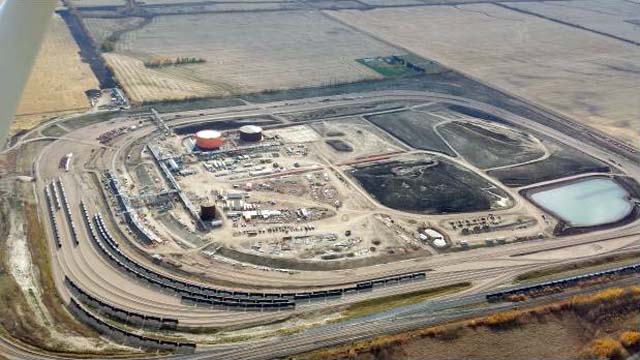|


Canexus is building this crude-to-rail terminal near Bruderheim - Date/Photographer unknown.
18 October 2013
Canexus Taking Oil-by-Rail to
Another Level Near Tiny Alberta Town
Bruderheim Alberta - Just outside this tiny town, Canexus Corp. is building the largest crude oil-to-rail terminal in the Edmonton
region.
While the recently expanded terminal can handle up to 50 rail cars a day, by this summer a new, highly automated and efficient circular yard with multiple
sidings will send 180 cars, in one or two unit trains per day, loaded with diluted bitumen to major U.S. refineries on the Gulf Coast.
Each rail car carries about 700 barrels of oil.
Thanks to contracts with "a portfolio of producers, the new terminal becomes a strategic centre for originating large scale oil shipments by rail from
Alberta," said Canexus chief executive Gary Kubera.
While the existing Bruderheim terminal needs thousands of semi-truck tanker loads each month to fill its rail cars, the new terminal will rely solely on
pipelines.
A new link with MEG Energy's nearby terminal, which is hooked to the Access pipeline from Cold Lake, will be operating within weeks.
And this summer Canexus signed a deal with InterPipeline Polaris to hook its Cold Lake pipeline system to the new terminal.
Canexus expects to spend $225 million for its new terminal and related facilities for unloading diluent from rail to pipeline.
The condensate can be hauled back from the U.S. after the diluted bitumen is unloaded, further strengthening the economics.
In fact, a recent Raymond James study found that efficient unit trains can haul crude for $20.50 per barrel to the U.S. Gulf Coast, which is about $2.50 per
barrel less than current mixed rail shipments and about $5 per barrel less than what small shippers can be charged by pipeline companies.
To gain that efficiency, Canexus will bring in a 120-car unit train (118 dilbit carrying cars, with two buffer cars) to its yard, inspect the cars, weigh
them, and then move them over to a filling area where 12 filler arms will extend hoses into the empty cars.
Loading can take one hour per car, so the unit train can be back on its way within 20 hours.
During this time the diesel engines will run and move the train as needed around the yard.
Without the need to assemble trains, the ready-to-go unit trains simply move onto either the Canadian National or Canadian Pacific lines that run through the
Canexus site and head out to a single destination.
With pipeline expansions becoming a challenge, major terminals like this one are part of the answer.
Gibson Energy has partnered with U.S. Development Group to build a similar size pipeline-to-rail terminal near Hardisty, and it plans to begin shipping two
unit trains per day by early spring.
Canexus currently has about 560 workers building its terminal expansion and plans to begin sending out its first unit trains later this year. Further work will
see the terminal reach its maximum capacity of 13 unit trains per day by July.
Several other Alberta firms, including Pembina and Keyera, have rail-based operations for crude or condensate and are planning expansions.
Dave Cooper.



Vancouver Island
British Columbia
Canada |